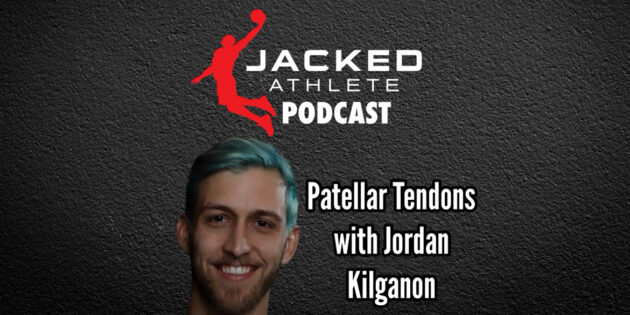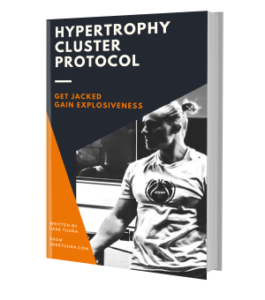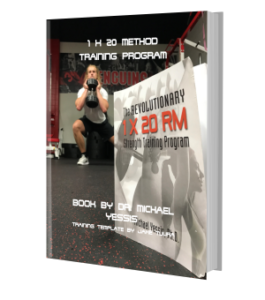https://podcasts.apple.com/us/podcast/jacked-athlete-podcast/id1462537296?i=1000706841163
“Since I was really young, I had jumped quite a lot. There’s been times in my life where I would get like really sore knees, even like 13, 14.”
“I literally didn’t get any knee pain again until I was maybe like 24. And at 24, that was just because I was trying to learn how to do speed jumping. I really wanted to learn how to do a free throw line dunk… I wanted to do the free throw line thing off one foot and that messed up my knee pretty good. You know, I didn’t know at the time, but tendons really don’t like change like that. And that’s a change, right? So I just stopped doing that and I went away pretty quick.”
“And then again, I went to try to jump off one foot, like a lot all of a sudden. And this is at around 26. And you know, had no idea how to treat it. I just kept getting worse and worse and worse. And so eventually I was like, hey, maybe if I just back off. So I backed off and then I would come back and hurt some more. So I backed off again and like just it, it was just a long and very stressful time.”
“Probably at like 27, I ran into a mentor and friend of mine, Christian Robertson, and also got to meet Jill Cook and Ebonie Rio in person as well too… And all that got me in the right direction.”
“Ever since then, I kind of rarely get knee pain. And if I do, it’s very short lived, like a week maybe, or at most two weeks, and it’s just gone. Like I have no problem taking care of that now, which is really nice.”
Fixing knee pain when young: “I think I just probably stopped jumping all the time for like a little bit and then probably started dunking every day soon after that. I was also jumping so much lower. I was just dunking on low rims, know, like eight foot, maybe nine feet.”
Low rim: “I remember at the time too, just talking to these other low rim dunkers on YouTube. I talked to many people who had knee problems. And then I don’t know if they had a rest period in between, I’m sure they did. But a lot of them who started dunking every single day just didn’t deal with knee problems for like a long time.”
Knee pain solutions from speed jumping: “I literally just stopped doing the speed jumping and pretty much went away.”
“The things that worked the most was a lot of stuff that was like very individual from Christian Robertson. And that was some isometrics for my adductors or my rectus femoris.”
Age 26: “When I started coming back and trying to fix my knee pain, I was still jumping all the time… And my knees were getting… So I just got better about my warmups. My warmups took a lot longer, doing 10% to 100% effort jumps… And then the other part was doing what I can do and then slowly progress that. So if we take something like the seated leg extension, slow and heavy, three seconds up, three seconds down. Three sets of six. And whatever you can do at 2 out of 10 pain or lower basically.”
“Alcohol, I could just sit there and have like a drink and my knee would just light up. It’s just, it would be ridiculous. It was actually really interesting because anytime I would eat certain foods and I would just sit there and my knee would just start hurting, I’m like, oh, okay, I guess we should chill on that.”
Adductor isometrics: “The test is kind of the exercise. So if you fail that test, you just do the isometric itself so that it’s actually turning on.”
“I’m getting older, so I have to be a lot more careful. I could go and turn myself into a one foot jumper if I want, but it’s kind of like, what is my priority? I would probably have to pull back a lot on my two foot jumping to make space for that. And I’m not willing to do that.”
Age 33: “If I jump off one foot all out right now, my tendons aren’t used to that. A lot of parts of my body aren’t used to how much power I’d be able to put out on it. I bet my one foot is still not bad right now, but I’m already trying to hold this fricking machine together as best I can. I’m not about to do that for now.”
Patellar tendon pain: “So it’s been all my left leg, all of it. So my left leg is my back leg when I jump off two feet. So it’s my leg where there’s like a lot of knee bend. The front leg doesn’t have much knee bend, but it has a lot of ankle ⁓ bending. So yeah, I got a bigger right calf and a bigger left quad.”
“There’s times I get a little bit in my right tendon, but that’s usually when my left is like super bad. The more I keep messing stuff up, the more that one will pop up. And then I’ve even had my Achilles tendinopathy pop up before and plantar fasciitis. Like when everything was falling apart, it was just like one, then the other, then the other, then the other. That was during the time where I didn’t know what to do. I just kept resting and it kept coming back.”
Patellofemoral vs. Patellar/Quad Tendinopathy: “End of the day, I don’t know. I don’t really care either. I’ve treated it the same way and it goes away.”
No warmup: “There’s sometimes it might be possible that I can just jump without doing much of a warm up. But my adrenaline has to be like pumping like crazy… if I have like a bunch of adrenaline, I don’t necessarily need as much of a warm up. My whole body just feels freaking ready. Joints and everything.”
“Your body eventually teaches you like, yo, just warm up. I will say though, I still don’t usually need much of a warm up for off vert jumps. Especially if I lower slowly and then start coming up fast and then really push off faster at the end.”
Dunk contests: “Some small like amount of pain, even 1 out of 10 pain, I don’t want the extra distraction.”
Warmups: “I’m very much as based off how I feel. I’ve become a bit more of an intuitive guy with my body. So I just kind of just do whatever I feel my body needs.”
“Leg swings, hip circles, walking lunges, some squats going slower to a bit faster to a squat jump at like 20%, 30%, 50%, 100%. And then I’ll do some off vert dunks. After that, then I will restart and do full approach run ups, starting at 5 % to 10 % to 15 % all the way to 100%.”
Dunk warmups: “The big key with this though, and everybody messes this up. When you tell somebody to go, okay, do a run up approach at 5%, they go and they just pop up while bending their knees like almost nothing. Like their legs are almost straight. I’m like, you’re not jumping from that position. Like you’re about to just do this pop up while almost standing like fully tall. And then you’re going to ramp up and then go into a hundred percent jump with a huge knee bend. Like that makes no sense. So I will go run up, get into the asymmetrical squatted jumping position. So I get into that position nice and softly, and then just pop up 5%. The next one, same position, pop up a little harder. So the 5 to 10 % doesn’t just apply to how hard you’re pushing off the ground, but how fast you’re coming into the approach to how much you’re handling the eccentric when you’re getting into that lower jump position then pop up.”
Isometrics for analgesia: “If I don’t have knee pain, I feel like I don’t really need it. But if I do have some knee pain, yeah, I’ll hit the leg extension… I’ll just hold it and I don’t usually do the whole 45 second thing. I do five to 20 seconds and just hold it there at the top. Sometimes at the bottom.”
Leg extension angle: “In the past, I used to really like doing the bottom versus the top. I felt that helps more for some reason. Maybe because that’s where my pain is.”
Frequency of dunk sessions: “For a long, time, this is like how I do my training. It’s jump day, leg day, upper, rest, and I just repeat… As I get older, I’m definitely letting myself rest a little bit more. I take a bit more time in between.”
“If you do go and try to do like a regular dunk, you don’t realize that you’re probably actually jumping at like 98 % or 95 % versus if you’re doing actual vertical testing with a vert trainer, that’s a lot more intense. Like I could do five jumps at a vert trainer. That’ll feel harder in my body than 10, 15 dunks.”
“I don’t really have sessions where I’m like, hey, today I’m only jumping at 80%. That’s not a thing. The only thing I will do is, if I feel like my body needs it is I’ll just jump on like turf or something like that, or just not do a jump session at all.”
“If I do a 360, it might light it up more because I get a deeper knee bend on 360s usually. But outside of that, dunks feel almost the same kind of stress.”
Volume of dunk sessions: “It kind of depends. If I’m having fun, I have a hard time stopping. I just love to dunk, so I would just keep going… But I believe my jumps end up being something like 20 (20 is super low, like almost never) to even 70 jumps (which is a lot). If I’m doing 70 jumps, especially now, I’m gonna be like, okay, I’m gonna get like a little knee pain pop up.”
Overjumping: “As time goes on, it’s not like I wonder if my knee’s gonna hurt. It’s like, okay, I’m expecting that my knee is gonna hurt… I know I’m being an idiot right now, but we’ll just have to take care of this.”
Cool downs: 100 % absolutely. There’s days where like I feel really like I really overdid it then 100% I’m doing a cool down. And what that looks like is honestly a lot of just what my warmup is. I will just kind of like redo some of my warmup other than the jumps, I’ll make sure I move around, bounce around, bring all my joints through their ranges of motion slowly. I’ll even do light stretches. I’m also doing isometrics for my adductors or for my rectus femoris, because those are usually the ones that will shut down.”
Ever got imaging on your tendons? “Nope, never got that.”
Ever got injections (PRP, stem cells, cortisone)? “No, never touched any of that. And all the people that I know that have done it kind of just do it all the time and are still having any problems. So I just kind of just like never convinced by it. I also just really hate needles.”
Plyometrics: “My favorites and my staples right now are depth jumps for sure off anywhere from 30 to 60 inches of a box and then just popping up and trying to keep my ground to contact time as short as possible while keeping my heights well. And then just seated jumps.”
“If I have some knee issues, the depth jumps and obviously the higher I go, the more that’s going to affect me like big time. Those are super aggressive. But so what you can do for that is either go from like a lower height. So I might not do my 60 inches might do my 30 inches box jumps, but even that’s gonna be super aggressive. So if my knees are hurting, I might go to the seated jumps, especially because there isn’t like a monstrous eccentric portion of it.”
“Pretty much all my plyometric training is the single effort thing… I don’t really care for doing them back to back. If you’re like more of an athlete where you’re playing basketball, then maybe I get it. The ability to stabilize yourself and balance yourself and then push yourself in another direction… But I feel like I’m not getting a true hundred percent effort jump on all of them [multi-effort jumps]. I’d rather reset and go hard.”
“If your knee starts to hurt more and more, you just put your knees less and less over your toes for a little bit.”
“There’s also a warm-up effect when lifting. Instead of three working-up sets, for me, it might turn into something ridiculous like six or even seven work-up sets.”
“Whenever people tell me that their physio said, you have a muscle imbalance. That’s my like red flag to be honest. I just never found that to be the case. I found it more to be the case of like, get it stronger. You know, like, especially for the quad, it’s like, oh, too quad dominant. I need to work more on my hamstrings to get rid of this knee pain. And like, for me, it’s just like, the quad’s not strong enough, my guy, get it stronger.”
Jumper’s Knee: “To be honest, there’s a lot of injuries out there that just get better on their own.”
Flare ups: “The higher you’re jumping, the more likely it’s going to be a thing. It’s more just that people decide to have mega sessions where they’ll fly out and go hang out with these group of dunkers and just dunk for like four hours straight… Like there’s a reason why I say maximum this many amount of jumps and don’t go above this.”
Bodyweight: “So I got to a point where I was jumping at like 186 and I actually thought a lot of these symptoms of me feeling like I was getting older was like, everything feels like I’m more robotic. I feel less whippy, less loose and everything like that. But then I cut some weight and I even went down to like 163, so I wasn’t just getting old. I was just got heavier. It’s like, I feel like young Jordan again. I don’t feel like a robot. I feel like I can move properly. And when you’re lighter, you can really just explode off the ground and be like a rubber band.”
“A lot of my guys who jump extremely high, I do actually have them have on a once a week [dunking] thing, but I also have them do a plyo day once a week. If they want to work on dunks more, cool. But I trust some of these guys. I’ve taught them a lot of stuff so that they can handle it and really upkeep themselves.”
“Do what you can do with no pain or almost no pain. And you can manipulate that by range of motion, by intensity, volume… And also the concept of, how is this? Half the weight, double the reps. Still too much? Half the weight, double the reps.”
Leg extension for jumper’s knee: “Stupid good success rate”
Jumper’s Knee advice: “Make the single leg extension your best friend.”
Jordan on Instagram: https://www.instagram.com/jordankilganon/?hl=en
Jump Master: https://my.playbookapp.io/jordan-kilganon
Jump Master X: https://www.jumpmasterx.com/home-copy
Jordan on YouTube: https://www.youtube.com/@killerjunior23



